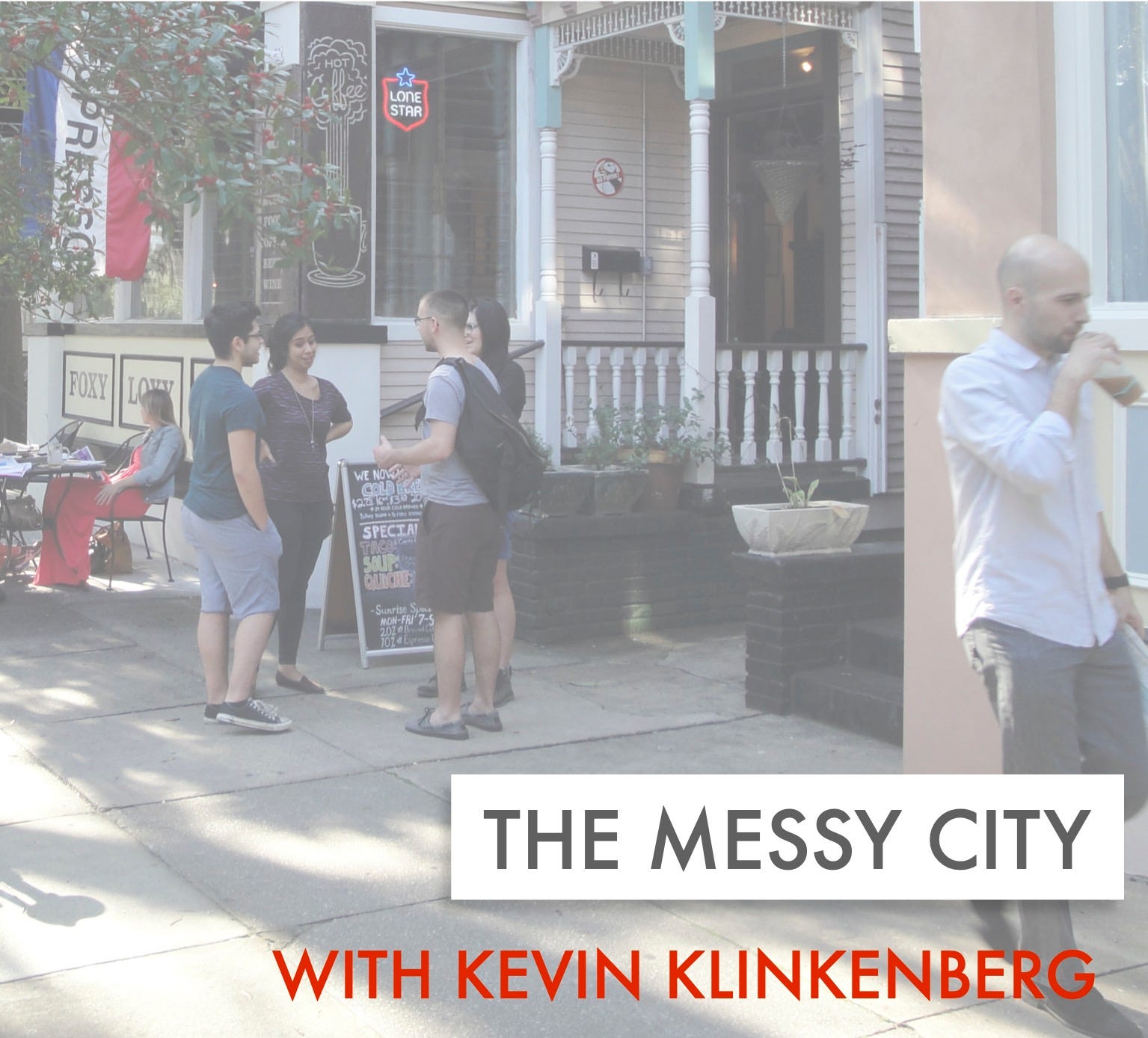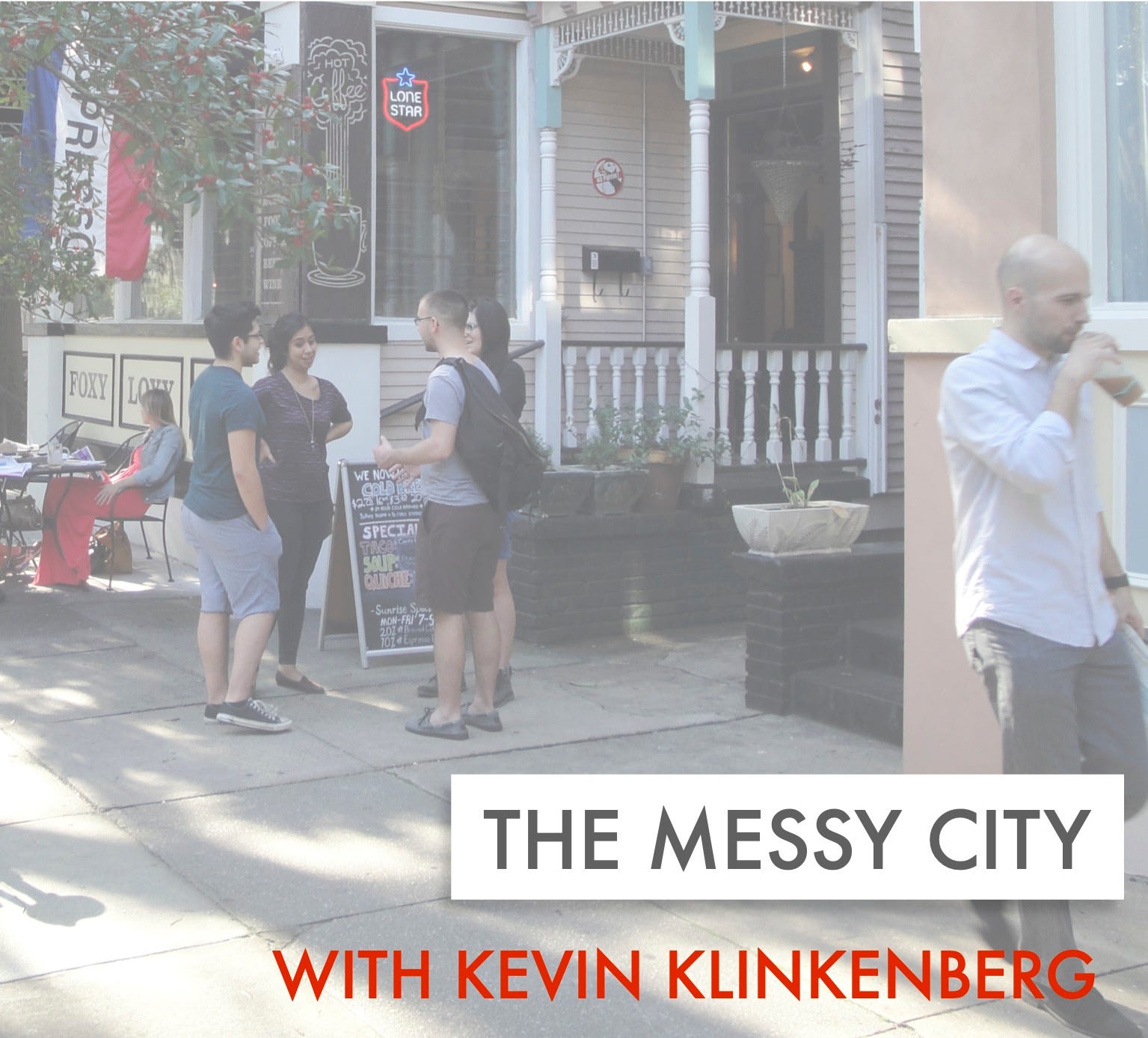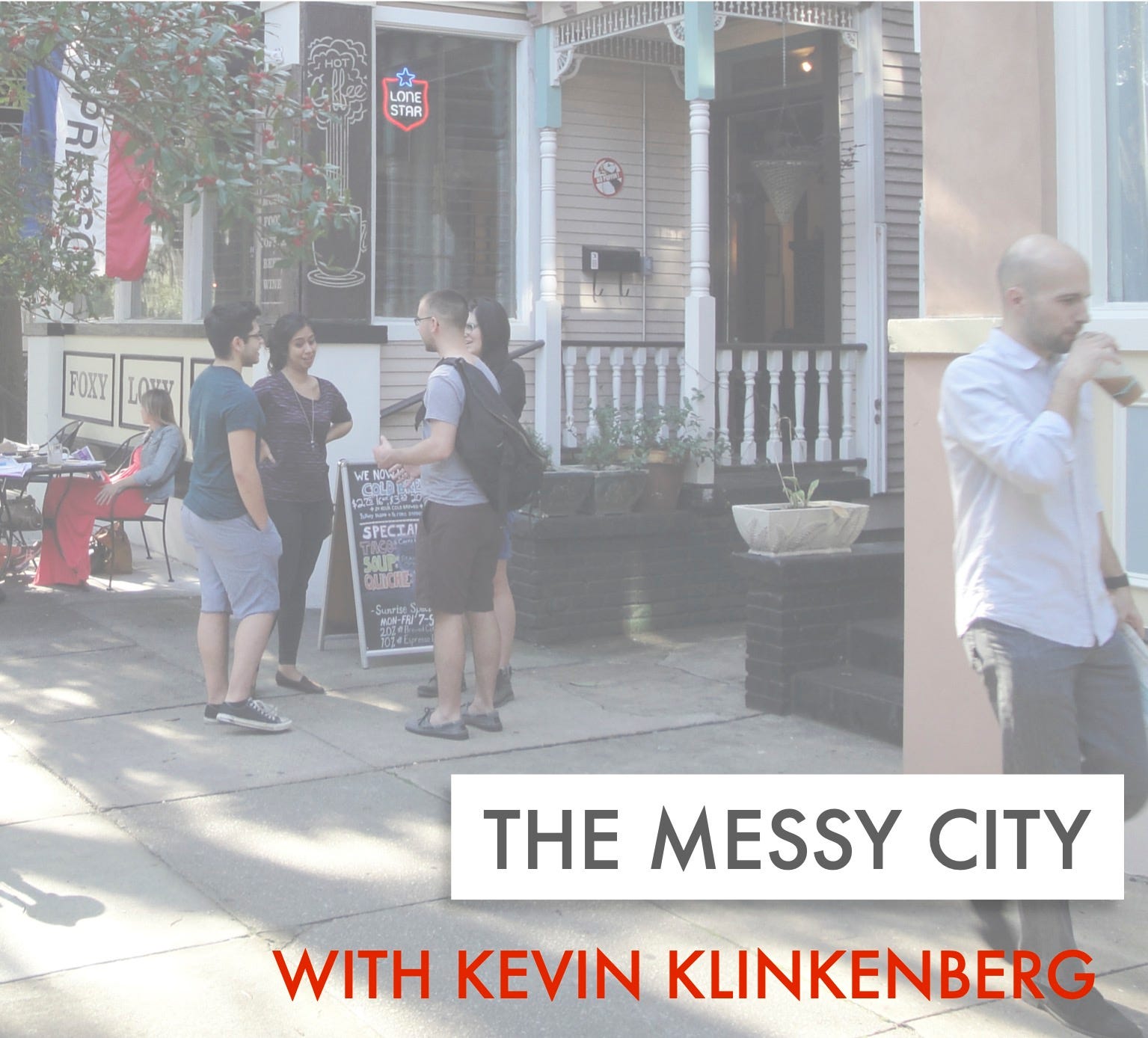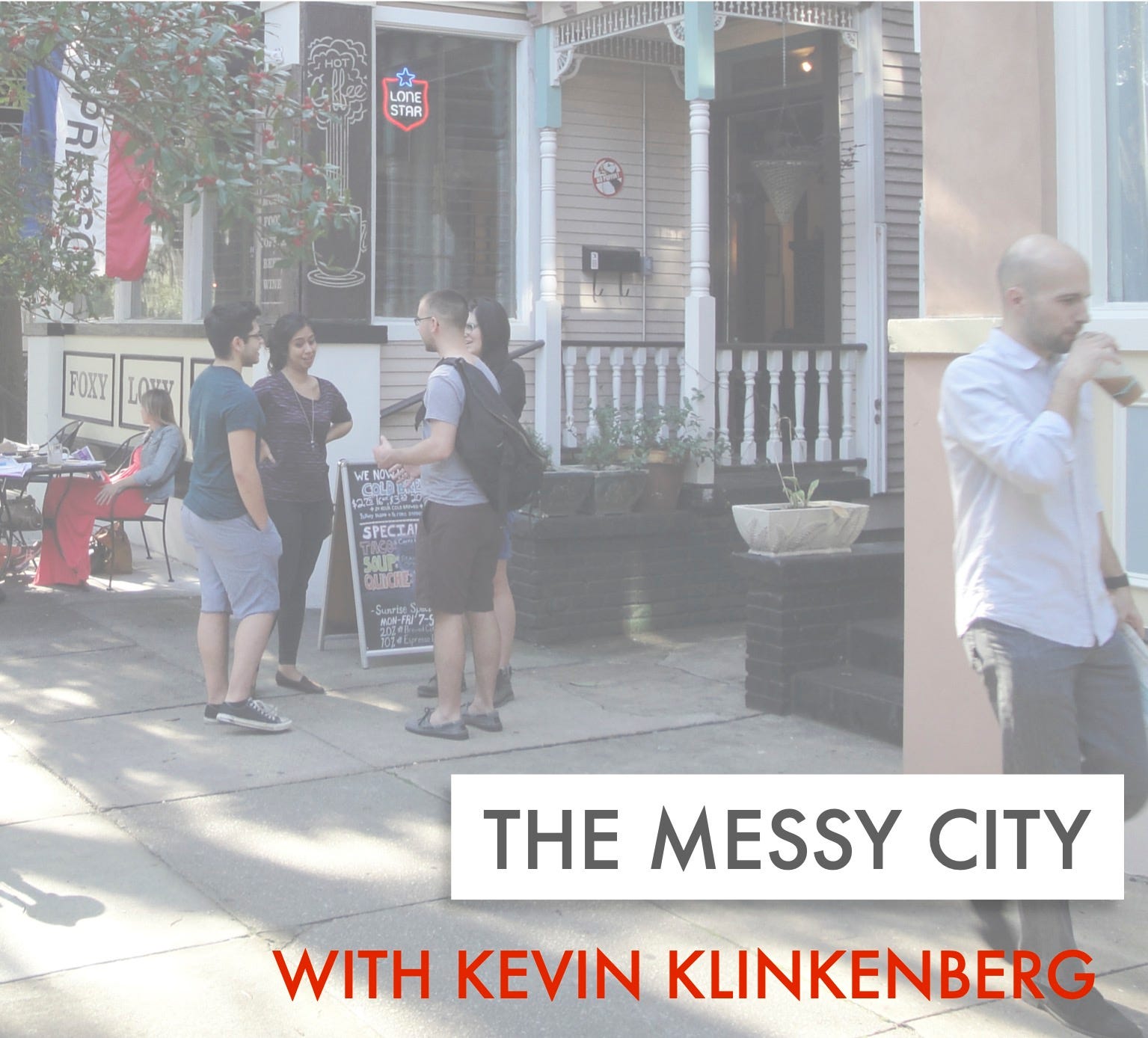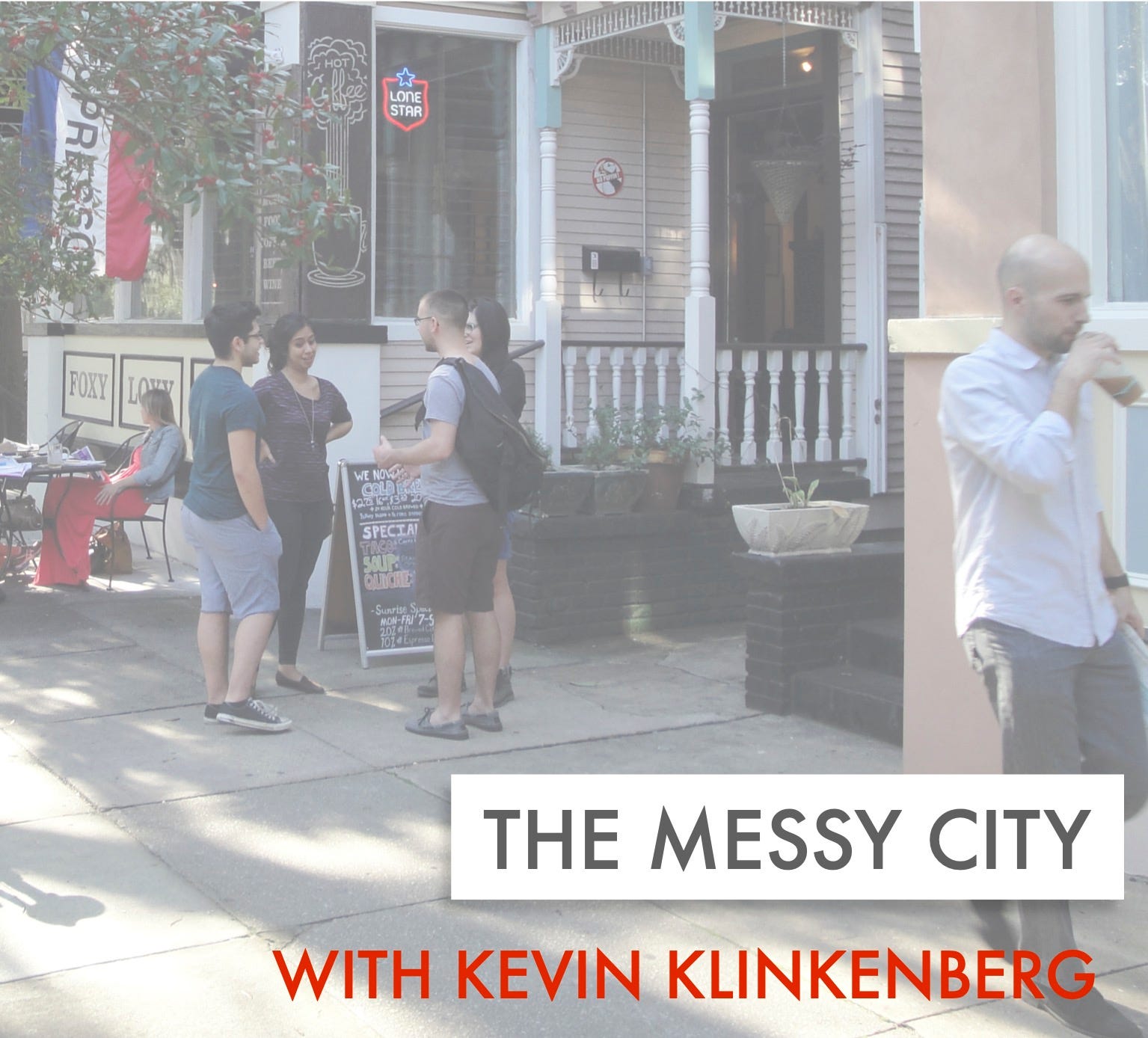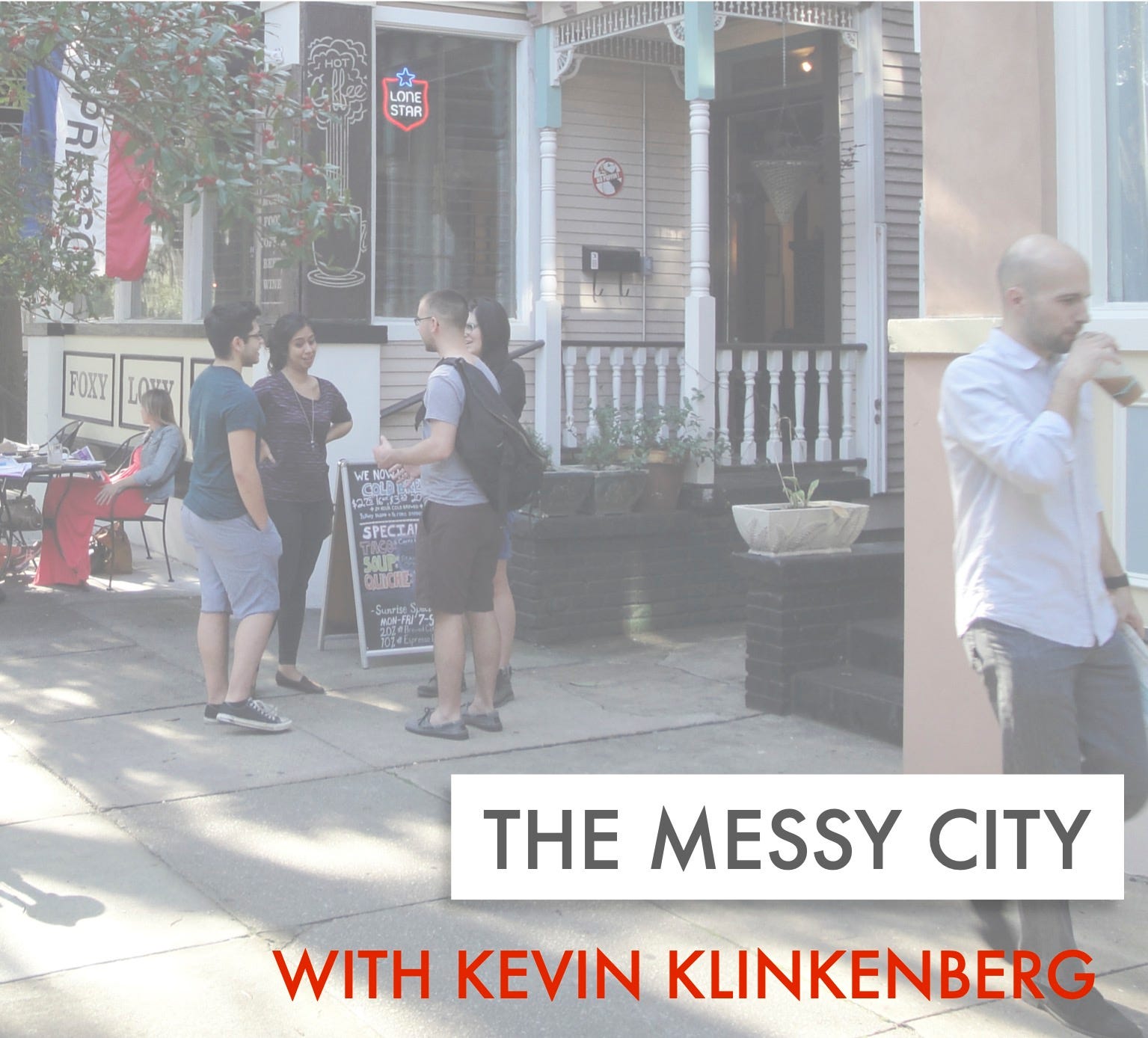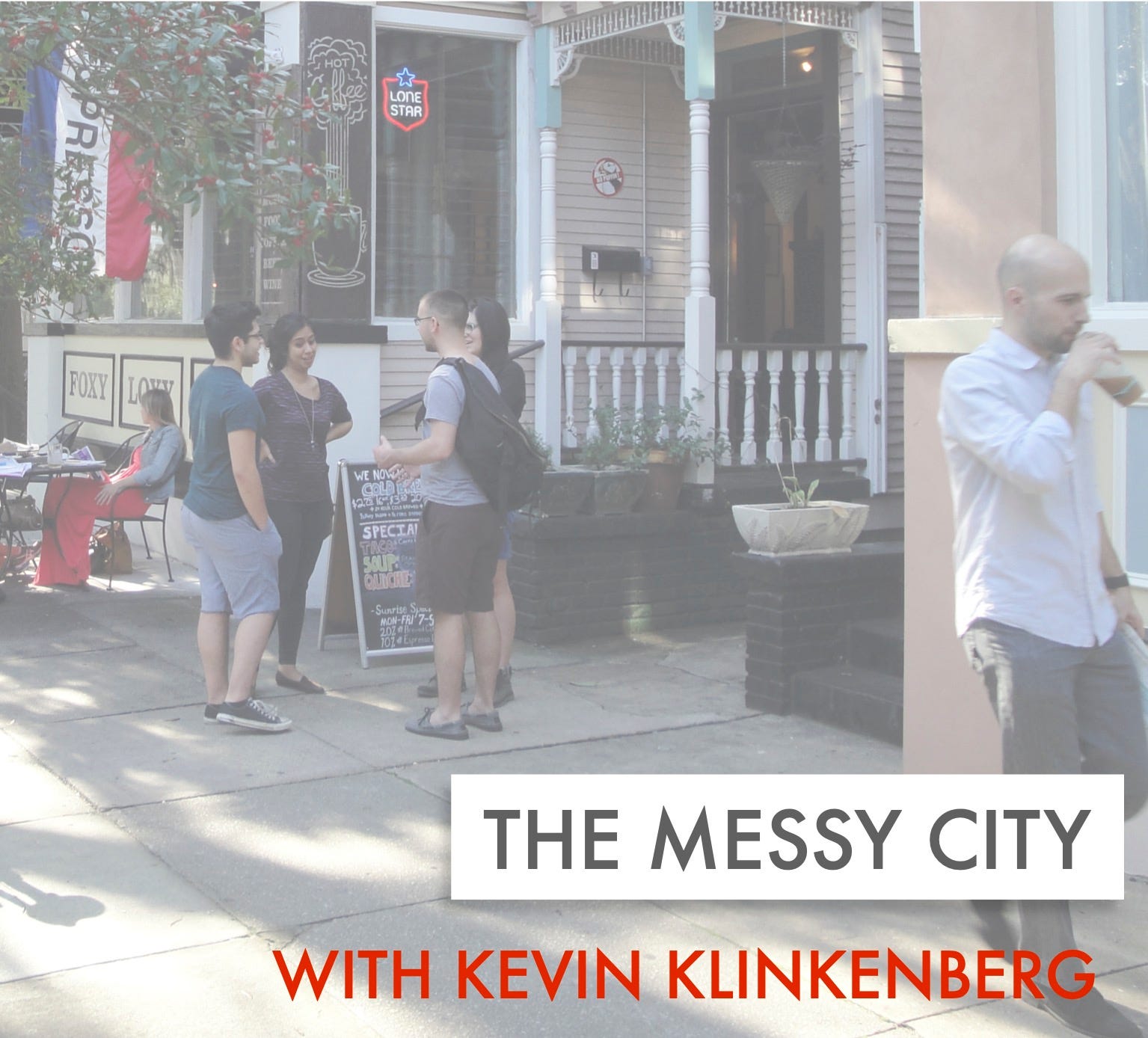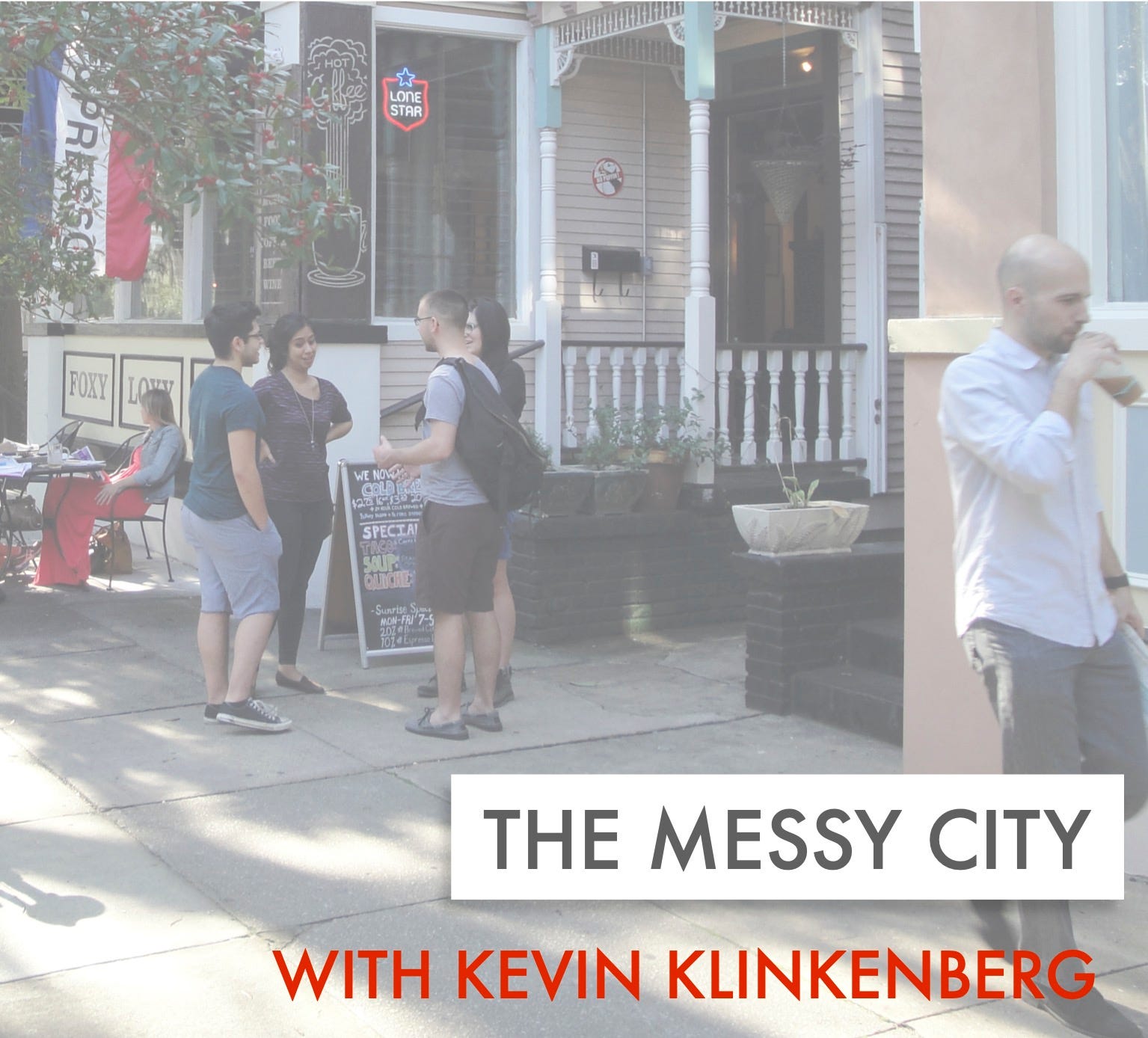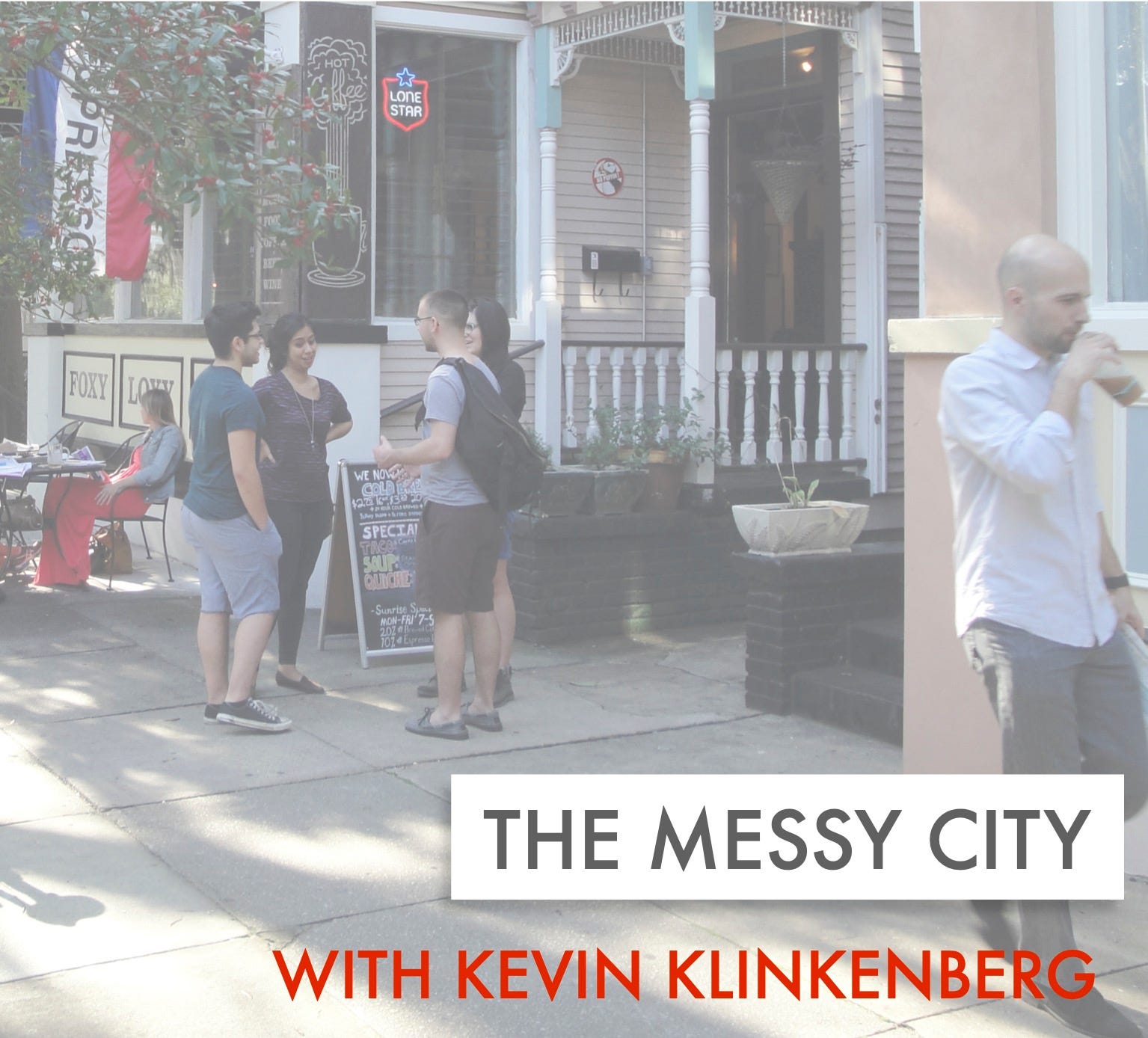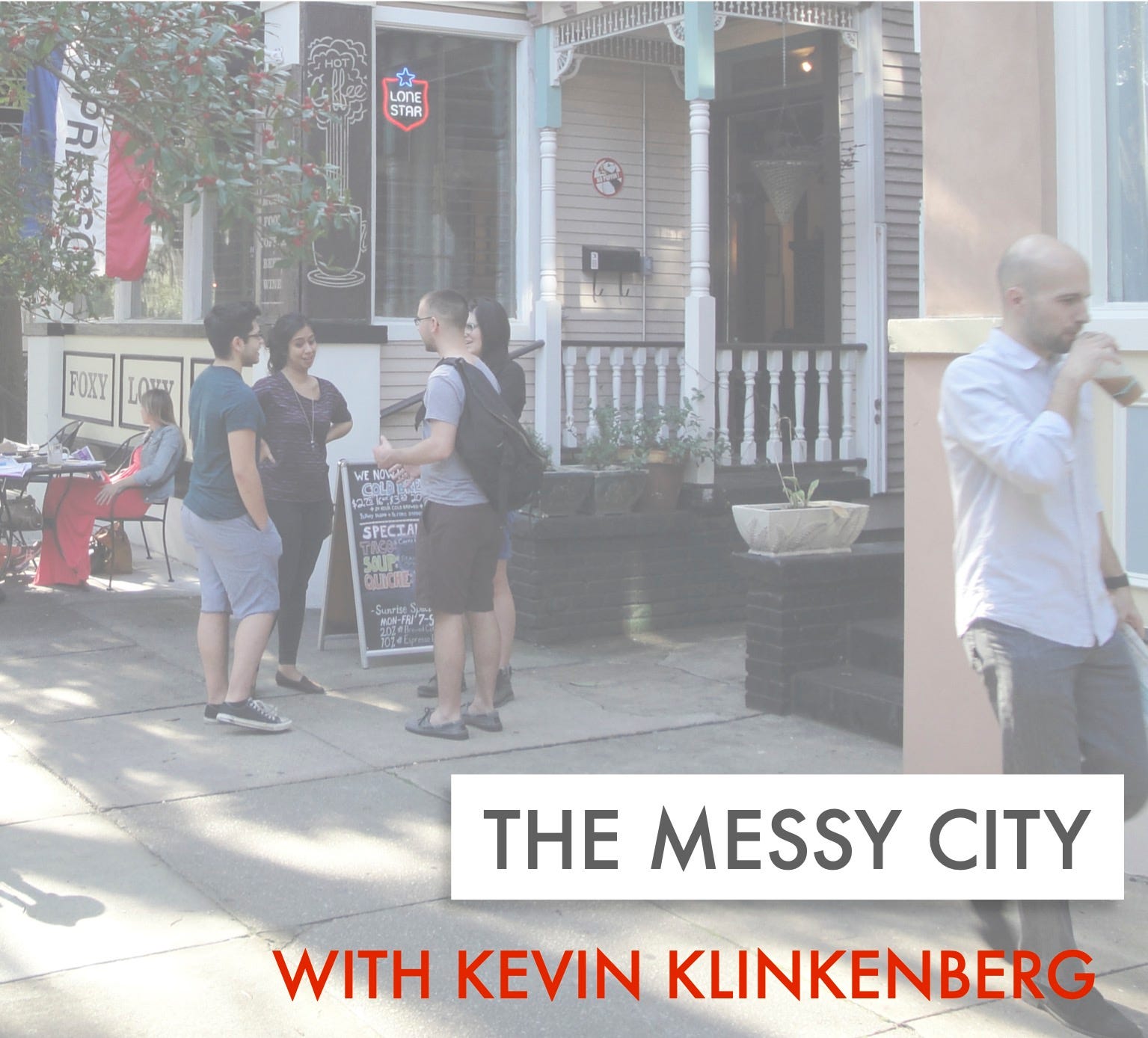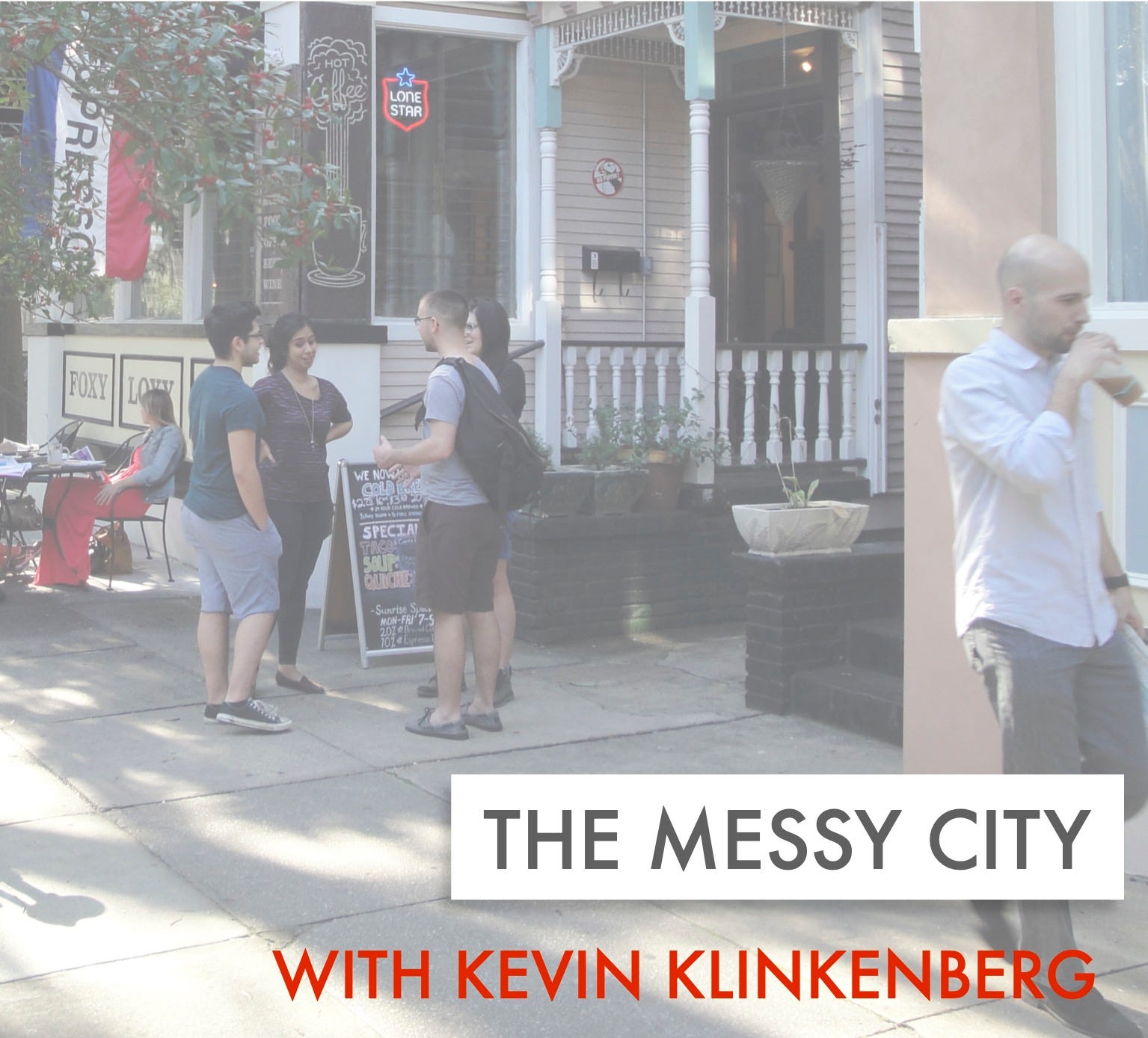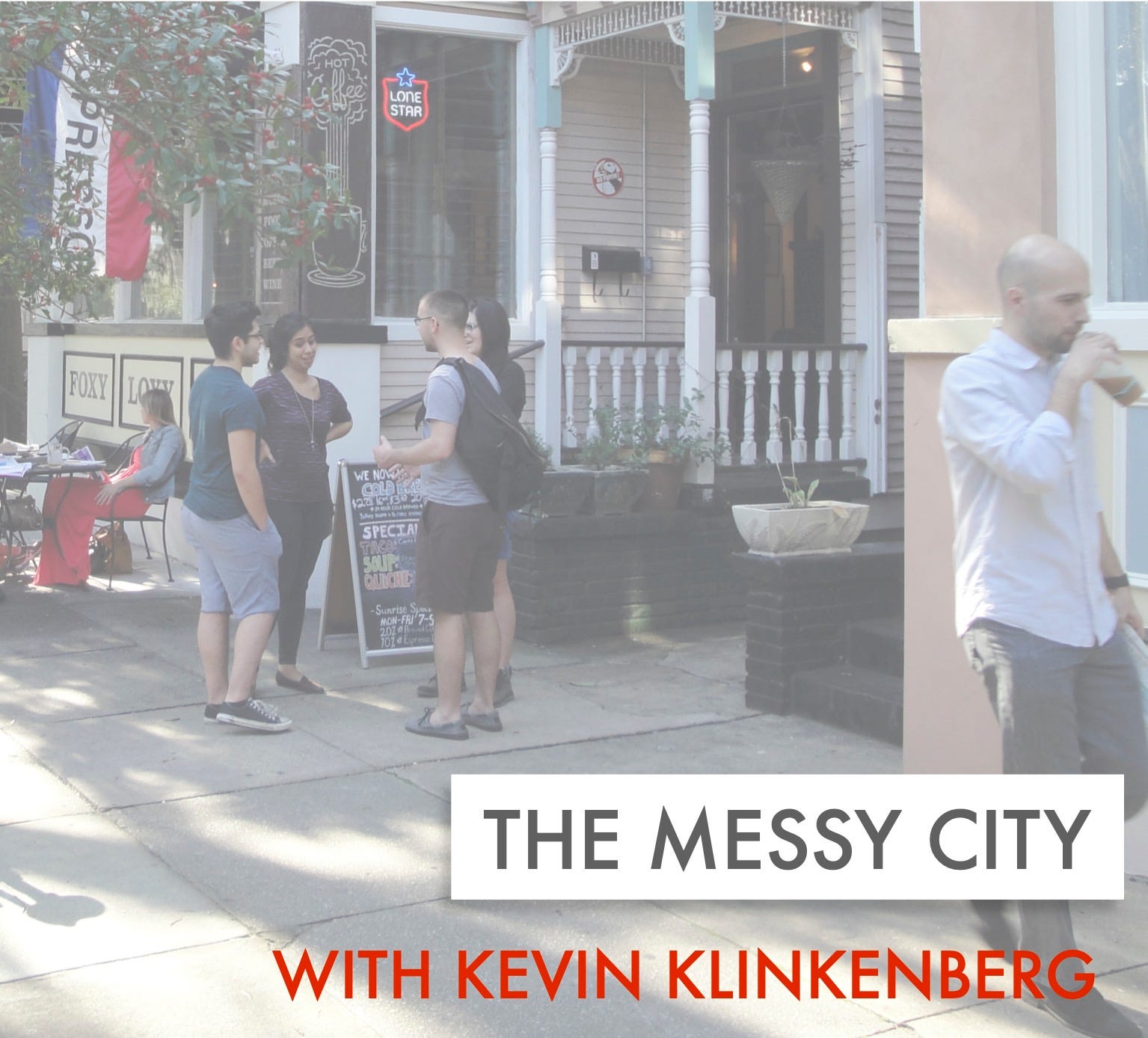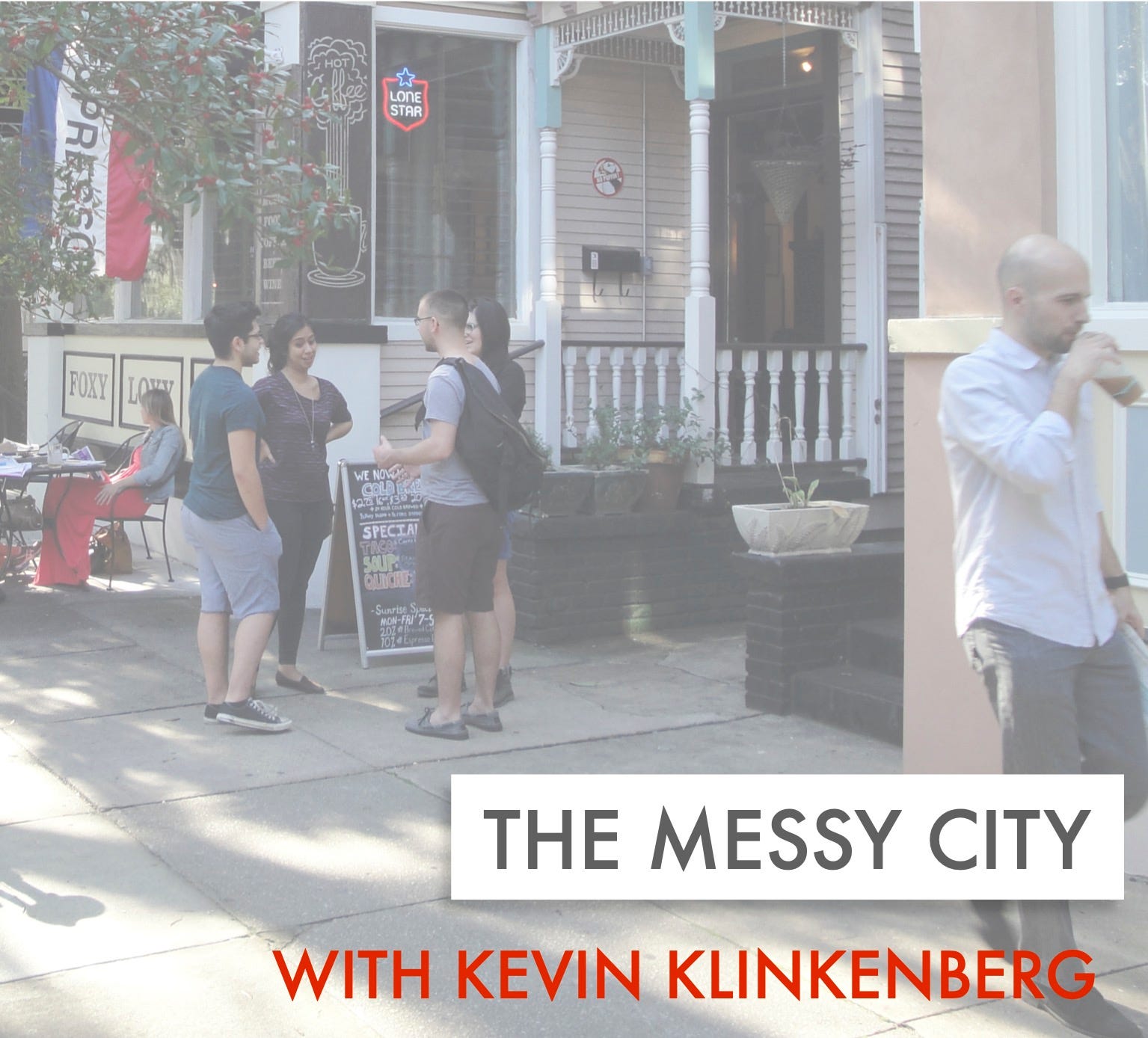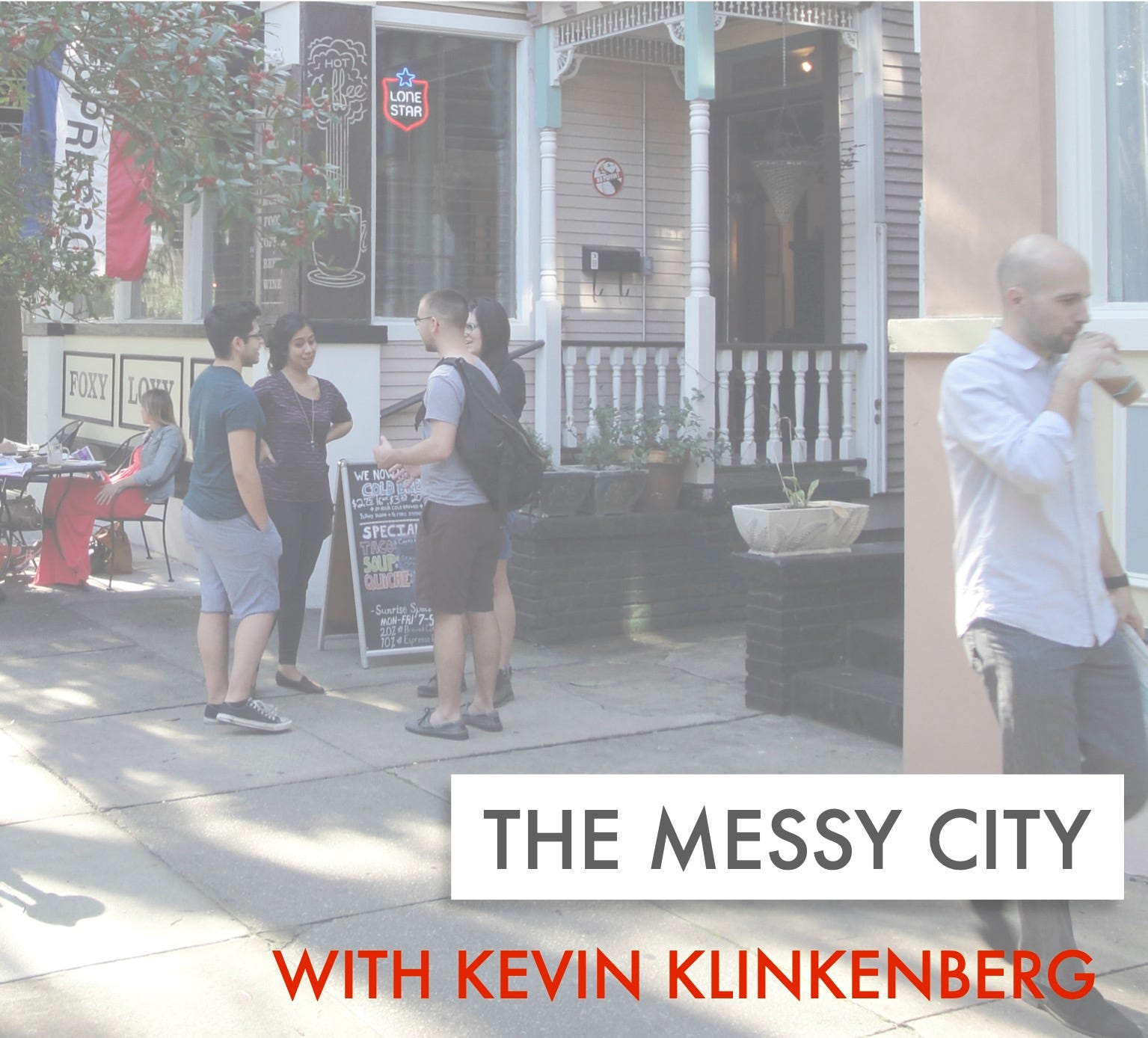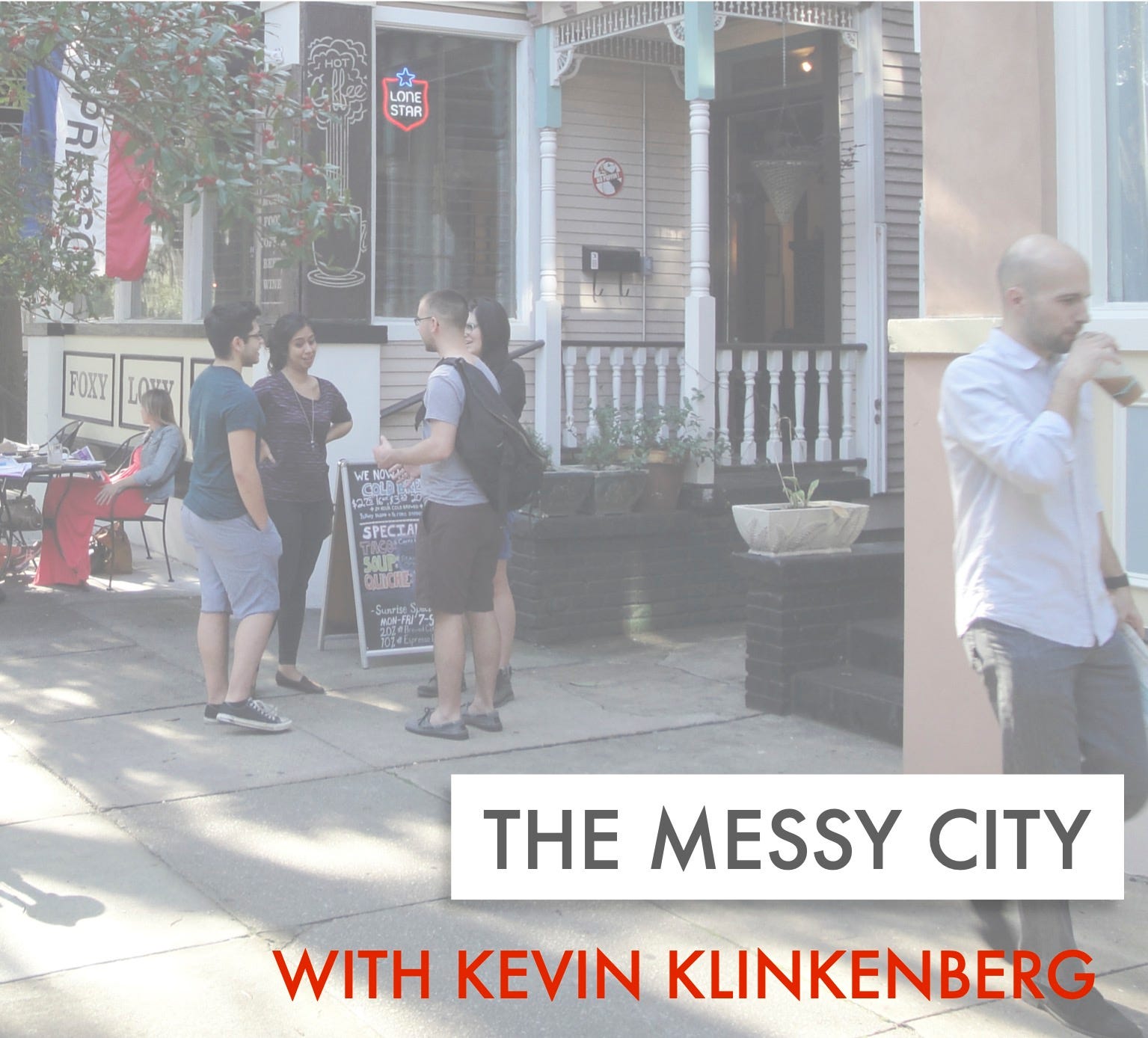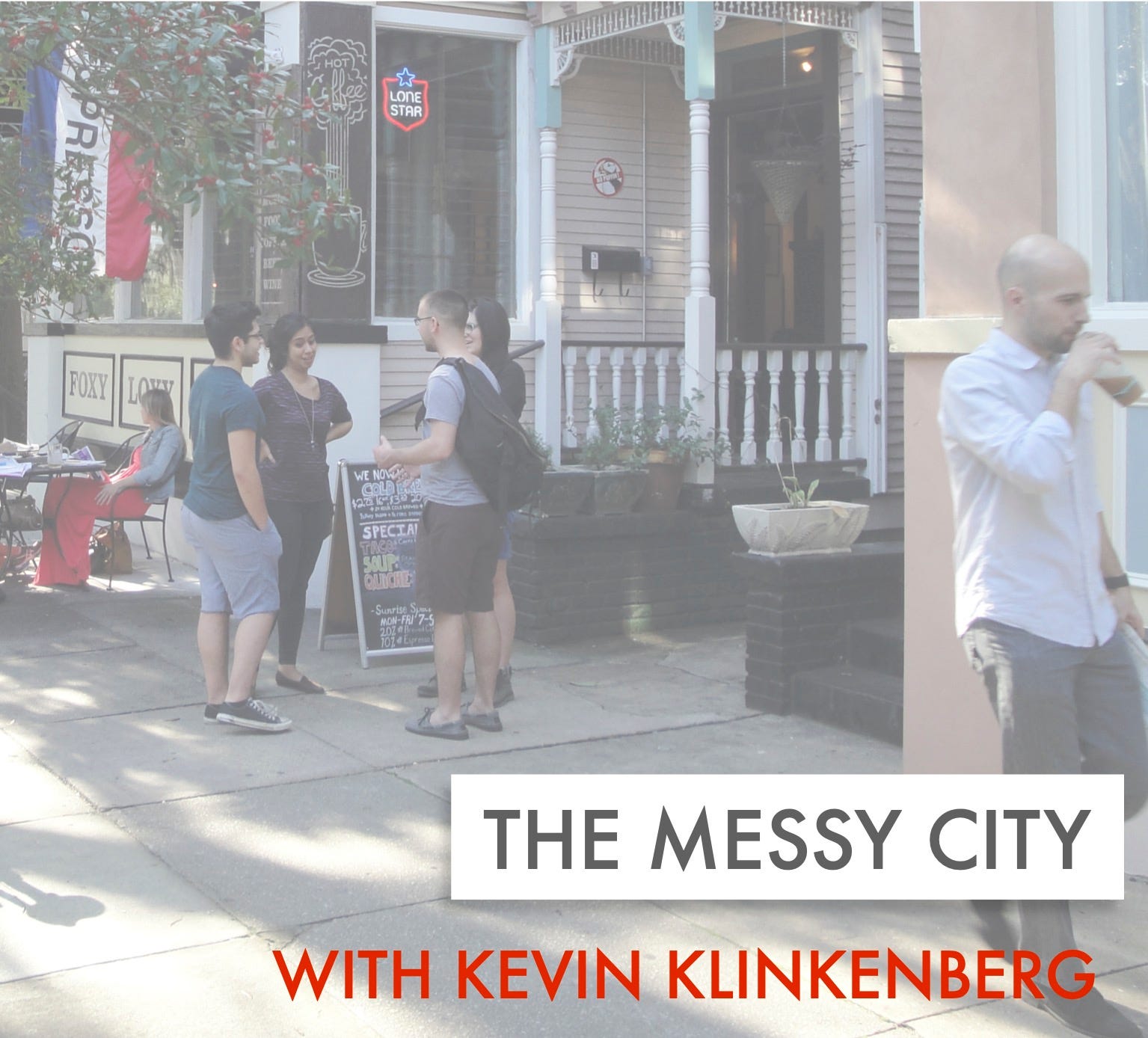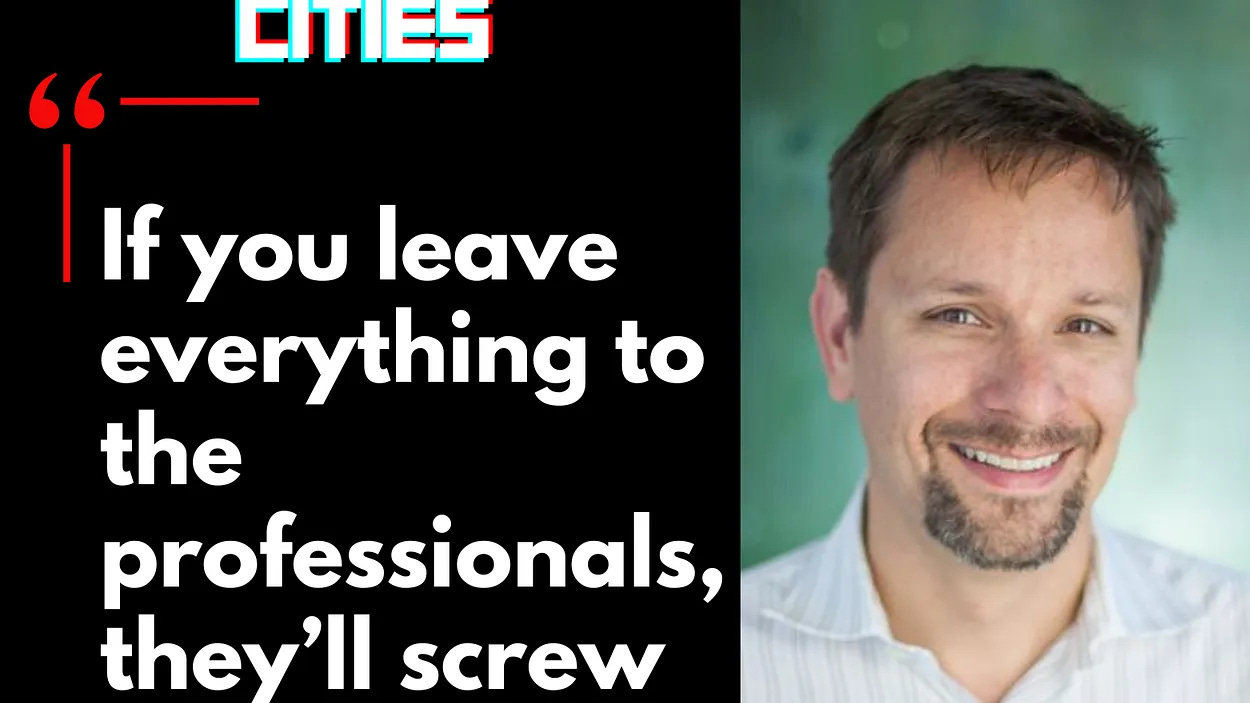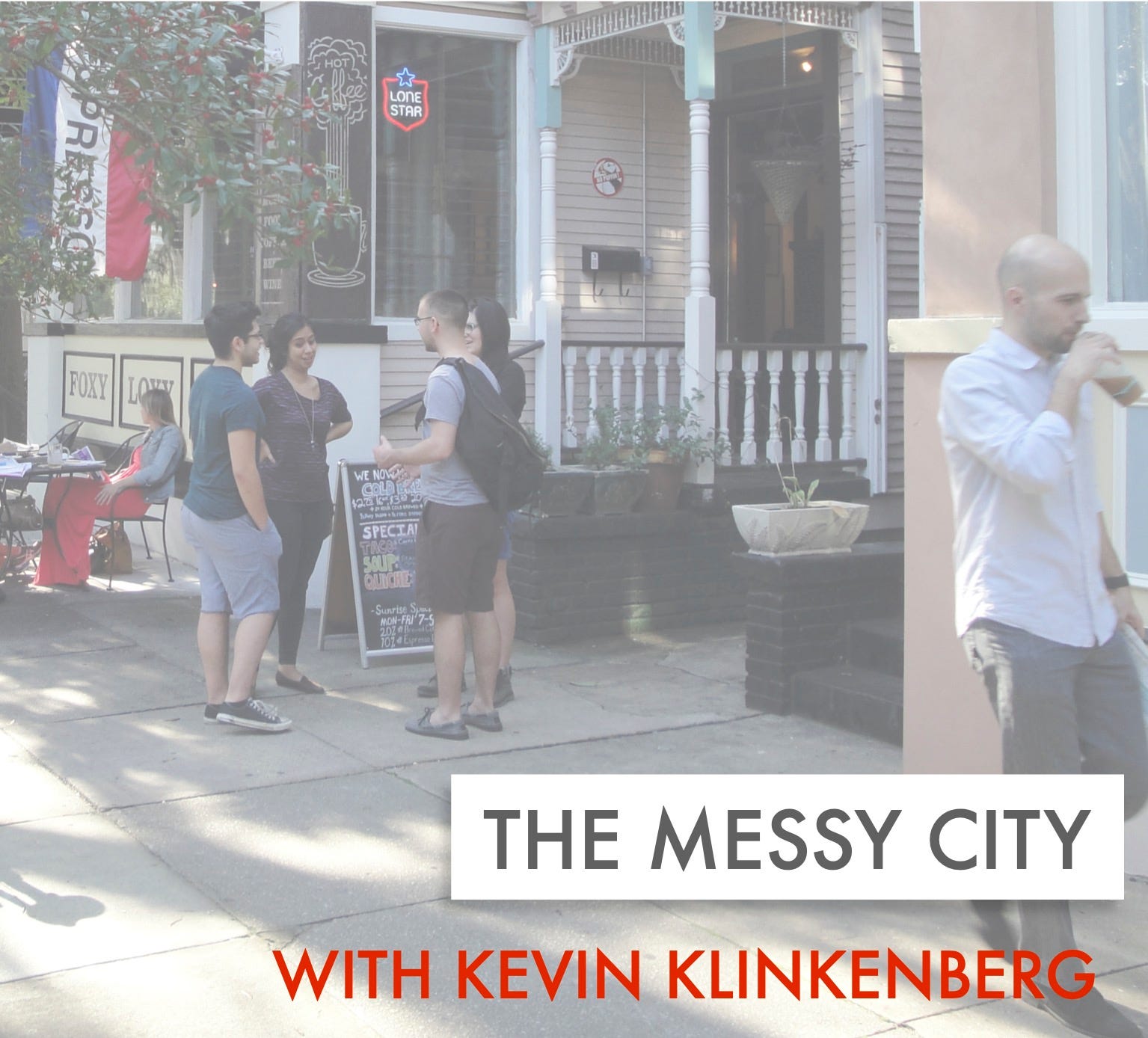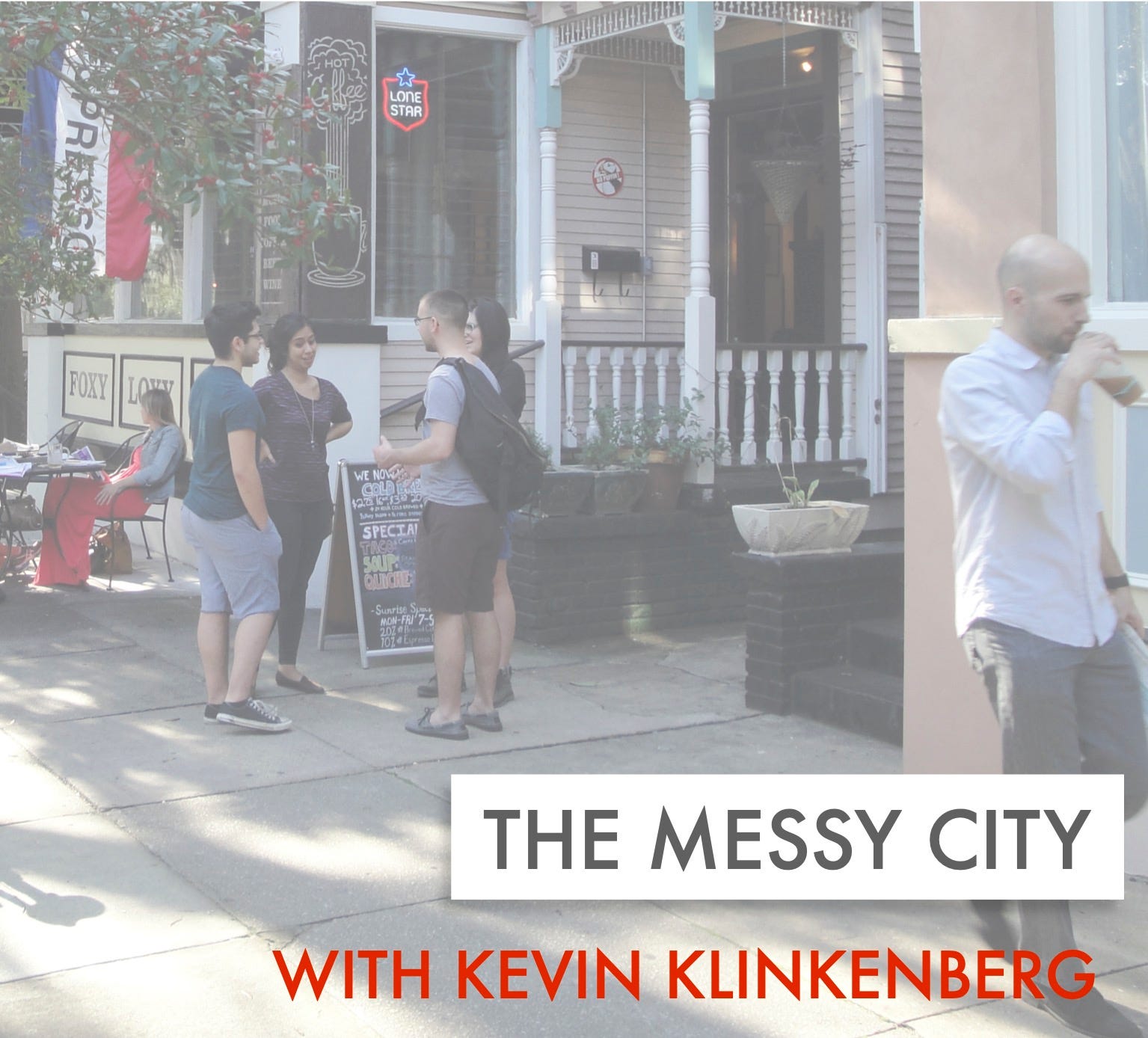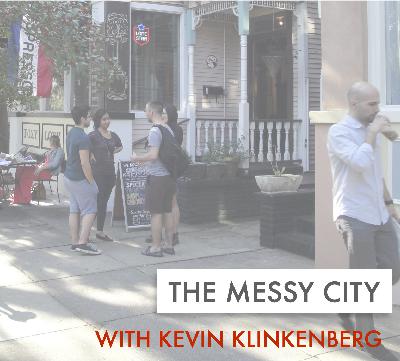Discover The Messy City Podcast
The Messy City Podcast

The Messy City Podcast
Author: Kevin Klinkenberg
Subscribed: 35Played: 1,025Subscribe
Share
© Kevin Klinkenberg
Description
Embracing change, uncertainty and local initiative for our cities and towns
kevinklinkenberg.substack.com
kevinklinkenberg.substack.com
111 Episodes
Reverse
For a guy that never intended to be a developer, Steve Nygren is having a remarkable impact on development and so much more. Steve led the development of Serenbe, which is a “biophilic” community southwest of Atlanta. This story is nothing short of remarkable. Even if nothing more had happened than getting 500+ property owners that control about 60 square miles of land to agree on a framework for future development, that alone would be incredible.But when you start to learn more and experience the town of Serenbe itself, it becomes quickly apparent this is a model worth emulating. Serenbe employs a more historic model of a rural village that is walkable and fairly dense, mixed with land set aside for agriculture and experiencing nature. Along the way, the community has touched the world of regenerative agriculture and New Urbanism both, along with a deep dive into thinking about healthy living.Steve talks about using your influence when you have the opportunity, and how to help the next generation. His book, “Start In Your Own Backyard: Transferring Where We Live with Radical Common Sense” dives deep into this philosophy and work. I would add, he’s also got a lot to share about how to bootstrap a large, master planned development.Find more content on The Messy City on Kevin’s Substack page.Music notes: all songs by low standards, ca. 2010. Videos here. If you’d like a CD for low standards, message me and you can have one for only $5.Intro: “Why Be Friends”Outro: “Fairweather Friend” Get full access to The Messy City at kevinklinkenberg.substack.com/subscribe
One of the mantras of small or incremental development workshops for years has been, “no one is coming to save you.” The solution to your neighborhood’s or community’s problem isn’t some outside force. It’s you. A similar mantra has been, “Brooklyn doesn’t need your butt.” Make it more colorful at your own leisure. We are often attracted by the allure of the sexy place, but it’s the not-sexy places that really need time, attention and effort from people who care.This episode gave me a chance to talk with someone who feels both those mantras deeply, and is doing something about it. Justin Pregont, from Pomeroy Development in Atchison, Kansas has taken up the mantle himself. He’s solving problems through real estate in his town, and in other rural towns across the state of Kansas. Justin was eager to see the types of interesting buildings and tenants he saw in bigger markets in his own town. So after realizing no one else was going to do it, he decided to figure it out himself. There’s a lot of inspiration, and a lot of hard reality in this episode. Maybe you think, I live in California or New York or Florida - what can I possibly learn from someone in small-town Kansas? Give it a listen, and then let me know.Find more content on The Messy City on Kevin’s Substack page.Music notes: all songs by low standards, ca. 2010. Videos here. If you’d like a CD for low standards, message me and you can have one for only $5.Intro: “Why Be Friends”Outro: “Fairweather Friend” Get full access to The Messy City at kevinklinkenberg.substack.com/subscribe
One of the most shocking pieces of information I’ve seen in the last year is how high the average age of all homebuyers has become. Depending on the source, I’ve seen between 59 and 62 years old. This is the *average* age. We’ve never seen a housing market quite like this, so I turned to Charlie Bilello, the Chief Market Strategist for the firm Creative Planning to help me understand it better. While I talk at length about the regulatory, design and policy aspects of housing on the podcast, Charlie is an expert in the financial side.We trace a bit of the history of how we changed the idea of housing from shelter to a financial product, and then hit on how those policy changes have created the mess we are in today. Charlie has a wealth of ideas that are admittedly unpopular, but could go to great lengths to fix the housing market over the short and long term.Along the way, we talk about fifty year mortgages, the impact of this issue on everyone under forty years old, the concentration of wealth with Baby Boomers, and why it’s so hard to make changes.If you want more from Charlie, check out his excellent YouTube channel.Find more content on The Messy City on Kevin’s Substack page.Music notes: all songs by low standards, ca. 2010. Videos here. If you’d like a CD for low standards, message me and you can have one for only $5.Intro: “Why Be Friends”Outro: “Fairweather Friend” Get full access to The Messy City at kevinklinkenberg.substack.com/subscribe
About forty years ago, the New Urbanism came on the scene with bold and creative ideas for building entirely new towns. The founders of the movement intended to prove that we could really build beautiful, walkable new places in America, much like some of our historic norms. Those early communities captured incredible attention, far beyond their actual size. And they’ve influenced a couple generations of people in the planning and development world.But it’s also true that most of the new places built were fairly modest in scale. Seaside, Florida, the famous community on the Florida panhandle, is just sixty acres in size. Many other new communities were the size of a suburban subdivision, or a smaller master-planned community. This isn’t a knock on the projects, it’s just the reality of what could be achieved and who the clients were.In recent years, an even bigger and more audacious proposal has come forward called California Forever. The founders have acquired over 50,000 acres in the Bay Area in Solano County. I speak with Gabriel Metcalf, the Head of Planning, to discuss the plans for this new community - the whys, whats and hows. This is a massive effort, and one that’s intentionally trying to renew notions of what can be done in a state that’s become famously difficult in which to build.Gabriel and I talk about not just the specifics of the proposed community, but how this effort fits into the historic context of new towns, and what he sees as precedents. Can we still build new places in America that are inspiring and solve 21st century problems? And what do new towns say about our existing cities and their struggles? We discuss all this and more.Find more content on The Messy City on Kevin’s Substack page.Music notes: all songs by low standards, ca. 2010. Videos here. If you’d like a CD for low standards, message me and you can have one for only $5.Intro: “Why Be Friends”Outro: “Fairweather Friend” Get full access to The Messy City at kevinklinkenberg.substack.com/subscribe
Andrew Burleson asks us to think about, “what is the system that creates space for people to live?” Systems thinking may seem terribly wonky, and in reality, it is. But systems thinking gave us the Constitution and the Bill of Rights and a whole host of ideas that underpin western civilization. Systems thinking was behind the movement that created administrative city planning and zoning in the 19-teens and 20s. YOU might not be thinking about systems, but someone else is. So the question is, what kind of systems do we want and need, that produce the best outcomes for human beings?Andrew is a man of many hats, not the least of which is he’s the Board Chair for Strong Towns. Beyond that, he’s a terrific thinker in his own right, and writes a Substack called The Post-Suburban Future. This episode is an outgrowth of a post he wrote called, “Could we create land use rules that work better for everyone?” If the episode intrigues you, read the post, too. He goes into even more detail with images there.The main focus of our conversation is a notion I described a few years ago, which is we need to “unleash the swarm” to solve our housing and development issues. Andrew does an exceptional job of describing the problem (all development now is discretionary and professionalized), and that our land use regulations essentially require stasis. Stasis sounds comforting to many, but it actually works against our intentions when practiced in reality.In this episode, we talk about how to de-professionalize housing, which is a phrase I really like, and how to drive incremental change by the context of a block or neighborhood. Andrew’s phrase that I love is, “the individual project is small, but the collective output is enormous.” As I reflected on that, it occurred to me that’s the entire spirit of the American experience, and one we’ve gotten away from to our detriment.Find more content on The Messy City on Kevin’s Substack page.Music notes: all songs by low standards, ca. 2010. Videos here. If you’d like a CD for low standards, message me and you can have one for only $5.Intro: “Why Be Friends”Outro: “Fairweather Friend” Get full access to The Messy City at kevinklinkenberg.substack.com/subscribe
Right off the top, I must say I always enjoy talking with Seth Zeren. Seth fits the mold of most of my favorite people, in that he’s a deep thinker AND a do-er. His ruminations are baked in the reality of trying to actually build things every day of the week, and he operates from a deep set of principles for placemaking. In other words, he really tries to get things done and done well - not just talk about them. Oh how I wish more people in the world of “advocacy” could be like Seth and also get their hands dirty building and developing. But that’s a story for another day.Seth wrote a piece on his Substack, Build the Next Right Thing, not long ago called “Two Great Tastes that Taste Great Together.” In that piece, he outlines what he sees as the strengths and weaknesses of both Strong Towns and the emerging Abundance movement, and how they can learn from and accentuate each other. I found it fascinating enough to want to talk about it all with him.Find more content on The Messy City on Kevin’s Substack page.Music notes: all songs by low standards, ca. 2010. Videos here. If you’d like a CD for low standards, message me and you can have one for only $5.Intro: “Why Be Friends”Outro: “Fairweather Friend” Get full access to The Messy City at kevinklinkenberg.substack.com/subscribe
A few months ago, we lost Leon Krier, one of the all-time greats in the world of architecture and urban design. I’m joined by Dan Parolek of Opticos Design to reflect on Krier’s work and influence, and his personal experiences working with him on multiple projects. Krier’s work and his many drawings have been foundational for so many of us that came through the world of New Urbanism. His simple, elegant way of dissecting what’s wrong with modern cities angered a lot of people in the architecture and planning establishment, but appealed to so many of us that knew something was wrong. In the end, there’s almost nothing about Krier’s work that should be controversial. He approached everything from the perspective of what is actually good for human beings. He felt we could and should learn from the acquired wisdom of the past and generations of people before us. That any of that should be controversial says so much about the era in which we live and how the design professions have mutated over the years.If you don’t know Krier, I hope this is an introduction. Please go check out his books. They’re incredibly easy to understand and read, and many are good for a laugh, too.Find more content on The Messy City on Kevin’s Substack page.Music notes: all songs by low standards, ca. 2010. Videos here. If you’d like a CD for low standards, message me and you can have one for only $5.Intro: “Why Be Friends”Outro: “Fairweather Friend” Get full access to The Messy City at kevinklinkenberg.substack.com/subscribe
Chuck Marohn of Strong Towns joins me in the studio to dive deeply into the world of housing finance and housing policy, fresh on the heels of his book, Escaping the Housing Trap: The Strong Towns Response to the Housing Crisis. For an architect and engineer to dive into this world might seem anathema to economists, but we go there anyway. The topics range from the thirty year mortgage and its distortions on the housing market to yield curve control to how social trust impacts the whole conversation. And we ask “do we actually have enough housing?” Coming soon I’ll have an episode about Leon Krier and his impact on so many discussions for architecture, planning and design today, but for now Chuck and I talk about one aspect of his ideas: height limits. Naturally, we focus on how that plays out in Washington, D.C.Find more content on The Messy City on Kevin’s Substack page.Music notes: all songs by low standards, ca. 2010. Videos here. If you’d like a CD for low standards, message me and you can have one for only $5.Intro: “Why Be Friends”Outro: “Fairweather Friend” Get full access to The Messy City at kevinklinkenberg.substack.com/subscribe
I’ve been an avid podcast listener since the early days of podcasting. It’s probably one area where I was a bit of an early adopter for technology. My guess is this is in part due to the fact that I grew up listening to a lot of radio, especially radio shows in the car when my parents were driving. So I suppose you can say I’ve always been interested in the audio side of conversations and entertainment.Back a few years ago, my brother finally nudged me into trying to do a podcast, after he’d gotten his started. His is all about the Mississippi River and the culture, environment and communities along it. Take a listen, it’s really good! He’s an incredible wealth of information about the river, and was even featured recently on Rick Steves’ podcast.But when Dean got me started, I wasn’t sure exactly how this would go, or if I’d enjoy having a podcast. Now here I am a few years later, with thousands of subscribers, and a milestone in episode #100. It’s been a wild ride, and getting more enjoyable all the time.So for this one, I decided to have some fun with two of my good buddies - Jason Carter-Solomon and Shomari Benton. Both have been on before, and both frequently offer great insights into life as well as the sorts of topics I delve into routinely - planning, development, design and small-scale real estate investment.We take some time on this episode to look back at our own lives, and we get a little personal. They even bring the questions to me, as we discuss our “why” for doing what we do, talk about career regrets, and think about what the future holds for each of us. I hope you enjoy it - we had a lot of fun doing this episode.Thanks so much for listening to these first 100 episodes.Find more content on The Messy City on Kevin’s Substack page.Music notes: all songs by low standards, ca. 2010. Videos here. If you’d like a CD for low standards, message me and you can have one for only $5.Intro: “Why Be Friends”Outro: “Fairweather Friend” Get full access to The Messy City at kevinklinkenberg.substack.com/subscribe
One thing that’s really obvious when you talk with Johnny Youssef is that he’s just a very positive and happy guy. And, frankly, it’s amazing what he’s accomplished at a still-young age. Johnny started his journey in Egypt, and eventually landed in Kansas City as a small developer and rental property owner. We talk about how he focused on the not-sexy parts of our region, and quickly built an income portfolio that has served him well.Johnny is the closest thing to a social media star that I’ve had on the show. In fact, almost everything we talk about can be seen on his channels, and I’d certainly recommend checking out his videos. In particular, his story of buying and renovating and old church here in Midtown KC is fantastic.There’s so much to learn from people like Johnny that just get in the game, take risks, and build. It’s a spirit we could use a lot more of, and in Johnny’s case I can’t wait to see what else he accomplishes.Find more content on The Messy City on Kevin’s Substack page.Music notes: all songs by low standards, ca. 2010. Videos here. If you’d like a CD for low standards, message me and you can have one for only $5.Intro: “Why Be Friends”Outro: “Fairweather Friend” Get full access to The Messy City at kevinklinkenberg.substack.com/subscribe
Kevin’s note: Apologies on the audio quality. Riverside did something funky to this episode, and I did my best to correct it.We all love to study success, and learn how to emulate it. Allan Branch likes to study failure. He studied it for his businesses, and for his city. Remarkably, it’s helped lead Allan to a lot of success in all his endeavors.Allan traces his roots from art school and family entrepreneurship to software and building businesses, to literally building buildings in his hometown. Of course, that’s not enough, so Allan decided to run for Mayor as well. And won.There are Allans in every city and town in America. And yet, very few of them actually have his success, or take the initiative to help fix local politics. I wish more would, as we’d all be better for it. Find more content on The Messy City on Kevin’s Substack page.Music notes: all songs by low standards, ca. 2010. Videos here. If you’d like a CD for low standards, message me and you can have one for only $5.Intro: “Why Be Friends”Outro: “Fairweather Friend” Get full access to The Messy City at kevinklinkenberg.substack.com/subscribe
Nolan Gray is the author of the very successful book, “Arbitrary Lines: How Zoning Broke the American City and How to Fix It.” If you’re in the planning and zoning world, you’ve likely heard of it or read it. If you haven’t, run right out and do it.Most of this episode focuses on the unique nature of Houston, Texas, and its approach to land use regulation. Often-scorned by planners because the city doesn’t have zoning, it actually provides a fascinating alternative to a process we know by now doesn’t work very well. And we dissect a few of the fears related to what might happen without zoning.Nolan has a deep knowledge of the history of zoning, and we touch a bit on how things came to be in the US context. Trust me - it’s not as boring as it sounds, but it’s also really important to know that this is a fairly young idea and institution. My editorial comment has always been: this was all invented by other humans, not all that long ago, and we shouldn’t be so afraid of even radical changes. It’s not the Ten Commandments, folks.We can dream of a repeal of Euclid v Ambler, even if we never get it. And who knows, we might even get to a result that’s actually more democratic in nature than what we have today.Find more content on The Messy City on Kevin’s Substack page.Music notes: all songs by low standards, ca. 2010. Videos here. If you’d like a CD for low standards, message me and you can have one for only $5.Intro: “Why Be Friends”Outro: “Fairweather Friend” Get full access to The Messy City at kevinklinkenberg.substack.com/subscribe
A developer colleague recently said to me, “I’ve only lived and worked in an era where cities are getting better. Now, I’m not so sure that’s the case anymore.” His comment along with a whole lot of other inputs got me to thinking - what if he’s right? Today, I consider a potentially dark path for big American cities. Are we in the midest of a new era of decline and retreat from urban areas? Will this continue? Is the “vibe shift” going to be a good thing or bad thing for people that love and care about big cities?So let’s get real, and discuss what it all could mean. I may do a future podcast taking the opposite view, but for now I think it’s important to consider the possible downsides of recent trends. Those include cultural forces, but also technological and economic changes, such as the advent of AI.Come with me on a journey to the dark side…Find more content on The Messy City on Kevin’s Substack page.Music notes: all songs by low standards, ca. 2010. Videos here. If you’d like a CD for low standards, message me and you can have one for only $5.Intro: “Why Be Friends”Outro: “Fairweather Friend” Get full access to The Messy City at kevinklinkenberg.substack.com/subscribe
Mike Hathorne has been around the New Urbanism movement for over twenty years. That means he has that rare combination of idealism, practicality, and persistence. Nowadays, you can find Mike with Visionary Homes in Utah.While the principles of New Urbanism have guided his work for years, Mike has also been on the front lines trying to figure out how to get it all built. Like all of us, he’s had successes and failures. But that desire to connect to truly human values and needs continues to drive him forward. Mike and I talk about how the actual types of households in our communities are far more diverse than most realize. And, what that all means for people trying to build new housing. We pause for a minute to discuss the notion of why having diverse households in a neighborhood is actually a good thing, and how it helps communities.The changes in household makeup over the last 70 years or so is very stark, and surprises many people. I’ve found that most people still assume the 2 parents with kids at home is still the dominant household arrangement. It’s not at all, and we take a look at the numbers. For anyone trying to build or develop, or anyone trying to improve their community, this is really important baseline information. We can all imagine that world we might want to have, but we must start and work with the world as it is.Find more content on The Messy City on Kevin’s Substack page.Music notes: all songs by low standards, ca. 2010. Videos here. If you’d like a CD for low standards, message me and you can have one for only $5.Intro: “Why Be Friends”Outro: “Fairweather Friend” Get full access to The Messy City at kevinklinkenberg.substack.com/subscribe
If you’re fortunate and diligent, you’ll encounter people in your field that are just supremely knowledgable about the details, and willing to talk about them. Audrey Navarro, the Managing Partner of Clemons Real Estate in Kansas City, is one of those people. I’ve found Audrey to be incredibly nice and pleasant to talk with, but also very ruthless (in a good way) with the numbers and the realities of real estate and development.In this episode, we trace her path that started from a simple duplex house hack, to now running a company with hundreds of apartments, commercial properties and even a construction arm. I particularly love how she says, “We sell math, not buildings. If you can get creative with the math, you can do just about anything.”Audrey and her firm have also endeavored to work in the “supportive housing” world, and we talk about the trials and tribulations, as well as the possibilities, for anyone taking on that ask. Lastly, we talk about WIRED, which is a very cool effort to encourage women to be more involved in the real estate business.Find more content on The Messy City on Kevin’s Substack page.Music notes: all songs by low standards, ca. 2010. Videos here. If you’d like a CD for low standards, message me and you can have one for only $5.Intro: “Why Be Friends”Outro: “Fairweather Friend” Get full access to The Messy City at kevinklinkenberg.substack.com/subscribe
You’re not going to find too many movies with developers as the hero. For most of the public, their opinion of developers is somewhere below Congress. And that’s saying something.I find that all unfortunate, since developers are the ones who build virtually everything in our world - our homes, our offices, our shops, our entertainment. And there’s a group of developers who have been undertaking honestly heroic efforts for two or three decases - those trying to build “new urbanist” or walkable projects. Some of these are small, and some quite large, but they’re all challenging.Ward Davis is one of those guys. He’s been at it in Northwest Arkansas for a couple decades now, and has all the scars to show it. He also has had a lot of success, and he’s someone worth learning from when it comes to the ins and out of development. His company is High Street Development, based in Fayetteville, and he pretty much works just in that very fast-growing region.There are a LOT of gems in this episode, so I highly suggest you stick with my lousy audio recording to hear it all. Ward and I talk bout what their approach is with doing “town center” types of projects, how to make money doing it, what is wrong with the development business, and the promise but pitfalls of doing small-scale “incremental” development. In a certain sense, this is a great companion piece to my interview with John Zeanah from Memphis, as they both are trying to figure out how to change our many flawed systems, and get beautiful places built that stand the test of time.I love how Ward says, “There's not a business in the country that looks easier from the outside and is more difficult on the inside.”Find more content on The Messy City on Kevin’s Substack page.Music notes: all songs by low standards, ca. 2010. Videos here. If you’d like a CD for low standards, message me and you can have one for only $5.Intro: “Why Be Friends”Outro: “Fairweather Friend” Get full access to The Messy City at kevinklinkenberg.substack.com/subscribe
From Iain, whose excellent site you can find at this link:The term 'messy' is a growing one when it comes to cities just now, and it's a refreshing one in what has for the last little while been the domain of the planner, who tends to see the world from the top down. But what makes cities, and indeed a lot of companies, so good is that they embrace what comes from the bottom up.In cities that means what's happening on the street, and how the people are shaping it. In companies it means the front line staff or factory worker being empowered to make changes when they notice something.Anyway, my most recent guest for Challenger cities was Kevin Klinkenberg who has been writing about The Messy City for a while now. So I loved hearing his stories of applying this in his own realm of Kansas City.We talked art walks, roundabouts, neighbourhoods, backyard cottages and the trouble of trying to be neat, tidy and perfect all the time. I suspect people will be really into this one, and a bit thanks to Karen from Strong Towns for making the connection! Get full access to The Messy City at kevinklinkenberg.substack.com/subscribe
Usually when a Kansas Citian talks about Memphis, it’s to discuss their bbq vs ours. And trust me, they do make some good ribs on Memphis. But today we are here to learn about housing and redevelopment. The City of Memphis has taken some solid steps in recent years to reform all manner of codes and processes to enable more and better housing options. John Zeanah joins me to discuss the specifics.There’s a lot in here for the policy wonks, and I’m here for it as well. But what I love the most is the attitude displayed by John, and his statement that they want to be problem solvers, not just regulators. What you hear from him is someone not content to check a box, do a plan and let it sit, or issue platitudes. This is what it looks like when people get their hands dirty, and truly work to fix issues that need fixing.The episode I had with Emily Hamilton is a great companion to this one, where she went into detail on State-level reforms for housing policy.For more, here’s John’s website.Find more content on The Messy City on Kevin’s Substack page.Music notes: all songs by low standards, ca. 2010. Videos here. If you’d like a CD for low standards, message me and you can have one for only $5.Intro: “Why Be Friends”Outro: “Fairweather Friend” Get full access to The Messy City at kevinklinkenberg.substack.com/subscribe
Jed Byrne is a man of many hats, but what he really cares about is demystifying real estate development for ordinary people. Jed’s podcast, Dirt NC, focuses primarily on issues in North Carolina and especially the Raleigh/Durham/Chapel Hill “Triangle” area. Earlier this year, Jed and a group of people from the local Chamber visited the Kansas City region on a mission to learn from each other. I’m not sure they talked much basketball (Kansas - the birthplace of North Carolina basketball as the saying goes), but they did talk a lot about economic development. And while here, Jed had a chance to check in with our local small development group. We talk about why it’s important to have a local ecosystem of small developers like we have, and what he hopes to achieve by having one in the Triangle. Jed also has some insights on what it’s like to live in a fast-growing region, vs. the sort of slow and steady growth we have in most Midwestern markets.Find more content on The Messy City on Kevin’s Substack page.Music notes: all songs by low standards, ca. 2010. Videos here. If you’d like a CD for low standards, message me and you can have one for only $5.Intro: “Why Be Friends”Outro: “Fairweather Friend” Get full access to The Messy City at kevinklinkenberg.substack.com/subscribe
One of the critical dilemmas of our time for people in retailing is, how do you get people to put down their devices and come out to shop in the real world? Jaime Izurieta of Storefront Mastery, talks about how shopping has become commoditized, and what to do about it. We discuss how to create an experience that makes people want to come out, and how businesses are adapting to the new reality.Stay tuned through the whole episode, as we also get into an interesting discussion on money, Bitcoin and place-making.Jaime’s book: “Main Street Mavericks”Find more content on The Messy City on Kevin’s Substack page.Music notes: all songs by low standards, ca. 2010. Videos here. If you’d like a CD for low standards, message me and you can have one for only $5.Intro: “Why Be Friends”Outro: “Fairweather Friend” Get full access to The Messy City at kevinklinkenberg.substack.com/subscribe


